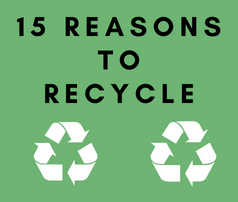 Green Benefits
Green Benefits
15 Reasons to Recycle

Have you ever stopped for a moment as you are once again sifting through your closet or dresser, deciding what to give away, and asked yourself, “Why is it even important to recycle these? What good does it do?” Our answer is that those are great questions! There are countless reasons to recycle textiles. From the health of our planet to decreasing demand in sweatshops to helping others afford gently used clothing to serving communities, there are so many reasons to donate textiles and not simply throw them in the trash. Here is a list of some of the reasons we have come up with to recycle your textiles…
Reduce Waste in Landfill
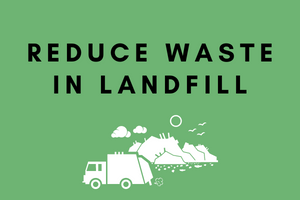
The first reason to recycle your textiles is to reduce the amount of waste sent to landfills. “More than 146 tons of municipal solid waste (50.0 percent) were landfilled in 2018.” (data found here) From this number, 11.3 million tons of textiles were landfilled in 2018. Both of these numbers increased from 2017 to 2018. Reducing waste sent to landfills has numerous benefits, from saving villages and cities money to slowing the number of landfills needed to accommodate our waste to reducing harmful greenhouse gasses emitted by landfill waste.
Reduce Greenhouse Gasses

The second reason to recycle your textiles is to reduce greenhouse gasses being emitted by landfills. “[Landfilled textiles’] lack of oxygen leads to decomposition through anaerobic digestion, which means that microorganisms break down the organic manner, producing byproducts like methane. Produced consistently and uncontrollably, methane escapes into the atmosphere, harming our air quality and our planet.” (quote found here) Reducing the number of textiles being sent to landfills can improve the air quality, and in turn improve the health of our planet.
Helps Others in Low Income Households
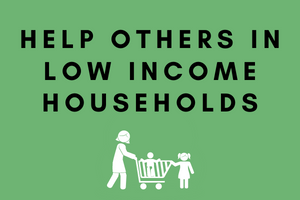
In addition to improving air quality and the health of our planet, recycling textiles also helps others in low income situations. “Selling gently used clothing at a discounted price can help families and individuals dress themselves with dignity and style without breaking the bank. This can help increase self esteem and even help one more easily gain better employment and social mobility.” (quote found here)
Helps Others in Your Community

In addition to helping those in low income households, recycling textiles also supports your community. When you recycle textiles locally, most charity shops or thrift stores use money from sales to pay it forward to different charities and organizations nearby. Whether it is a women’s shelter, or job training facility or serving the homeless, you can feel good about knowing your donations are helping others in your community. And of course, this is in addition to the other benefits of taking care of our planet.
Reduces Energy and Water Consumption
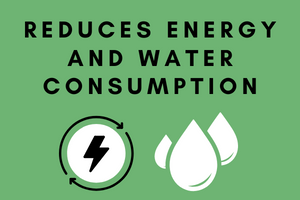
“Every piece of clothing you’re wearing has gone through a complex manufacturing process that uses a high amount of electricity, water, and other energy sources. Recycling clothes saves energy by reducing…the need to make materials from scratch.” (found here) How much does this help? “Manufacturing products produced from raw materials requires consuming a lot of non-renewable energy – up to 95% more energy utilized during the production of virgin materials as opposed to recycled materials.” (found here) Reducing the use of non-renewable resources helps care for our planet.
Sends Message to Fast Fashion

Another reason to recycle textiles and buy secondhand is to send a message to fast fashion that you are not okay with their current business practices. From constantly rotating fashions to never-ending new product lines, fast fashion produces constant pressures to keep up and buy more and more. By choosing to consciously step out of that pressure and focus on making conscientious choices about how you care for the clothes that you own and the new items you do buy, you can send the message by not supporting what fast fashion has to offer. Fast fashion companies AND consumers are responsible for making a new way for consumerism with more ethical practices and more environmentally-friendly methods of production.
Fewer Sweatshops

“The demand for clothing can often lead to outsourcing business practices that result in poor treatment of foreign workers and other basic rights violations.” (found here) In Pietra Rivoli’s 2005 book, “The Travels of a T-Shirt in the Global Economy,” she writes,
“According to figures from the U.S. National Labor Committee, some Chinese workers make as little as 12–18 cents per hour working in poor conditions. And with the fierce global competition that demands ever lower production costs, many emerging economies are aiming to get their share of the world’s apparel markets, even if it means lower wages and poor conditions for workers.”
Recycling textiles and buying secondhand reduces the demand for new clothing purchases and sends the message to fast fashion companies that consumers care for those who make their clothing and how it is made.
Helps Others in Developing Countries
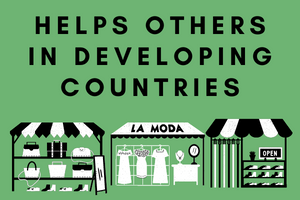
In addition to helping those in low income households and supporting those in our communities, recycling textiles can also help others in developing countries. When recycled textiles are sent overseas, workers are employed to sort through bales and other workers are employed to help sell the products in the market. The employment of workers and sale of these used textiles can help bolster a country’s economy when it is struggling to thrive.
Protecting the Planet for Future Generations
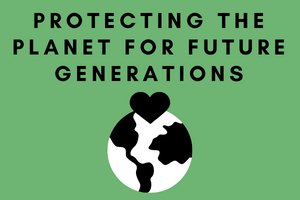
“The resources on this planet are ultimately finite. The two key fibers in the textile industry are cotton and polyester which represent over 85% of global fiber production. Cotton relies on a finite land mass for agriculture and competes with food production. Polyester relies on finite sources of oil (petroleum based) and its extraction is damaging to the environment.” (found here)
In addition to depleting finite resources in producing new textiles, there are many harmful environmental factors with sending textiles to landfills. From reducing waste and greenhouse gasses to reducing contaminated groundwater and deadly diseases, there are numerous reasons to recycle textiles to help protect our planet. Instead of contributing to its demise and playing a further role in the problem, we each can choose to help our planet become a cleaner and better place to live, both for ourselves and future generations.
Reduces Demand for Dyes and Fixing Agents

Another reason to recycle textiles is to reduce the need for dyes and fixing agents that contaminate groundwater.
“Textile products use dye when manufacturing from virgin sources – recycling allows less production and usage of harmful dyes. Many dyes do not degrade in water, while others produce harmful substances that leach into surrounding soil and groundwater. Recycling reuses materials that have already been dyed, which helps in reducing wastewater – another major contributor to large amounts of pollution.” (found here)
This is yet another factor in taking care of our planet. We have posted before about companies that are finding ways to reuse dyes in their textiles or ways around this harmful practice. By recycling textiles and buying secondhand, we can slow the process of this contamination.
Recycling Saves Money
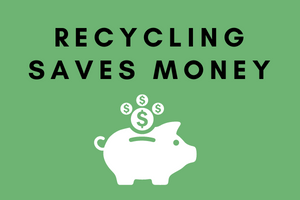
Contamination also occurs in landfills, which can cost villages and towns a large amount of money to maintain and clean up. When comparing costs of recycling facilities and landfills, “landfilling can be three times more expensive than recycling. The health cost benefits from reduced pollution and greenhouse gas emissions can add up to more than $55.00 per ton less than landfilling.” What causes these higher costs for landfills? “Landfills eventually leak. The toxic waste can seep into the ground, contaminating soil and water. Cleanup costs run into tens of millions of dollars [to] taxpayers.” (quotes found here)
Reduces Contaminated Groundwater
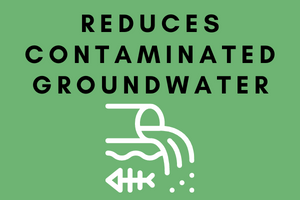
As mentioned in the previous two reasons for textile recycling, contaminated groundwater is a serious issue affected by production of new textiles and sending old textiles to landfills. The wastewater that results from using harmful dyes and fixing agents in textile production leeches into groundwater and pollutes water used by communities and wildlife. Textiles that are non biodegradable sent to landfills eventually leak toxic waste into surrounding soil and water, also affecting surrounding communities and wildlife. “Landfills leach a myriad of pollutants that range from heavy metals to priority pollutants to organic compounds that contaminate groundwater. Once groundwater is contaminated it is impossible to clean up and the EPA recommends abandoning the source.” (found here)
Recycling Creates Jobs
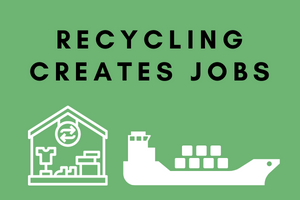
“For each one job that is created by a landfill, recycling processing can create 10 new jobs, and an additional 25 jobs are created by recycling-based manufacturers.” In textile recycling, there are nearly countless jobs to fill: thrift store employees, graders, sorters, downcyclers, barge operators and shipyard workers, researchers, entrepreneurs, chemical recyclers, designers, seamstresses, jobs for you and me who sell used items on internet platforms, and on and on.
Reduces Deadly Diseases

One more reason to recycle textiles is to reduce potential deadly diseases from contamination in landfills. In their post on reasons to recycle, Cacala states “inhaling greenhouse gasses can lead to respiratory ailments, and contaminated water leads to infectious diseases like typhoid, diarrhea, and dysentery.” When we choose to recycle textiles, we decrease the amount that is headed into landfills, thus reducing the amount of greenhouse gasses emitted and reducing the amount of pollutants contaminating the groundwater.
Buying Used is Fashionable
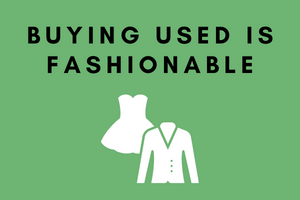
“Repurposed, recycled, and reused clothing is gaining a larger niche each year in modern society. Thrift store finds are not only good for the environment, humanity, and your wallet, but they are also actually very fashionable.” (found here) We have posted before about buying used and vintage at the Holidays for a one of a kind piece to give to those you love. Resale sites are growing exponentially and include millions of sellers and buyers scouting items for rare and vintage, as well as everyday used items in good condition. In our previous blog on the Conscious Closet, Elizabeth Cline talks about purchasing vintage items in thrift stores and on online resale platforms to create her capsule wardrobe and her own unique look.
Recycling Textiles
Here at Chicago Textile Recycling, we are thankful for each of you who chooses to donate old textiles. “By supporting an initiative like clothing recycling, you are not only taking action against overconsumption, violation of human rights, and environmental degradation, you are contributing to your own personal empowerment.” (found here) Textile recycling and shopping secondhand are small ways to help out in big ways. For more information about acceptable items or any questions you may have, please contact us.